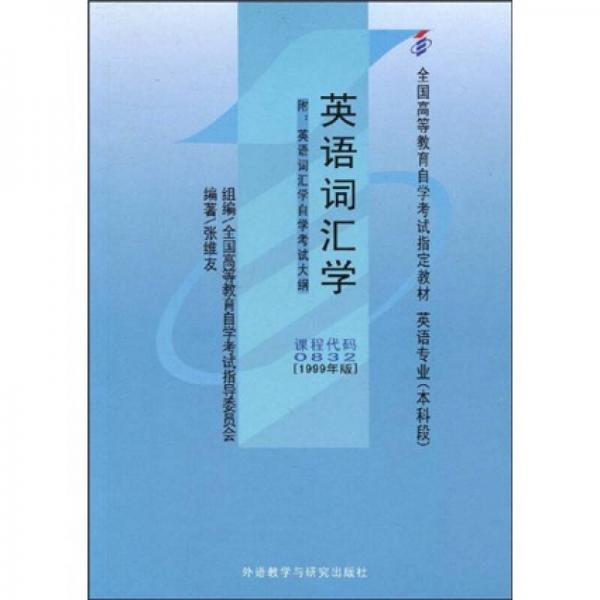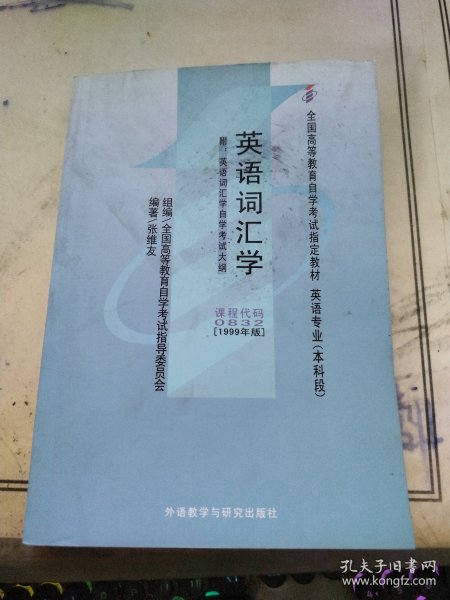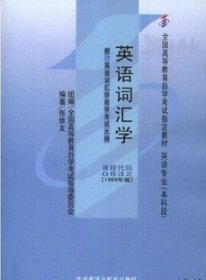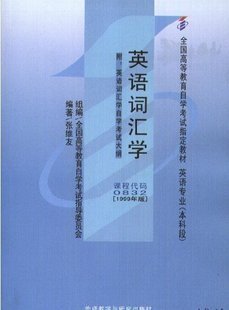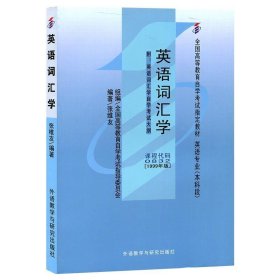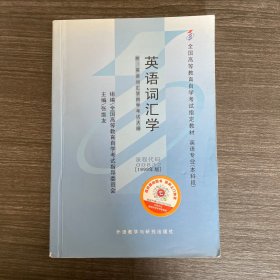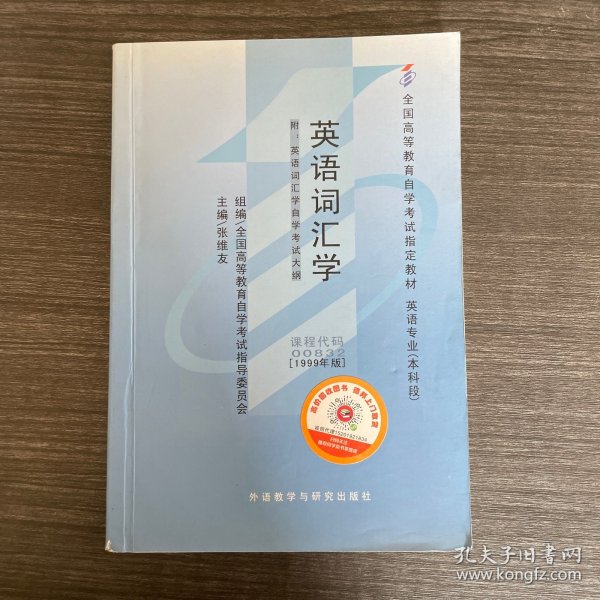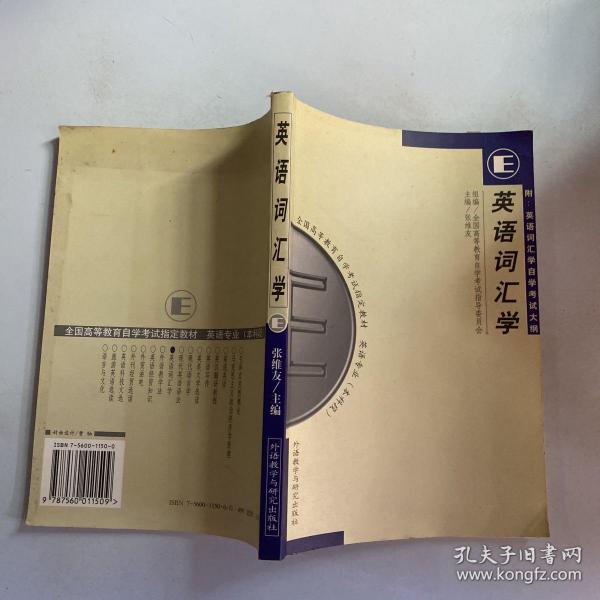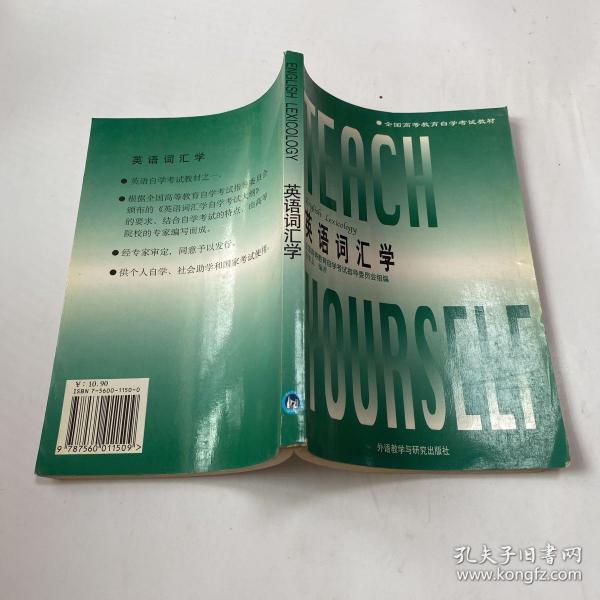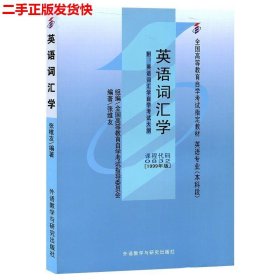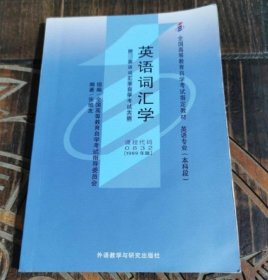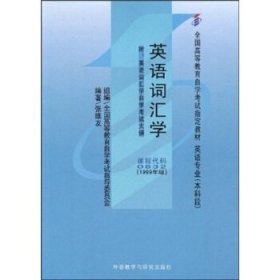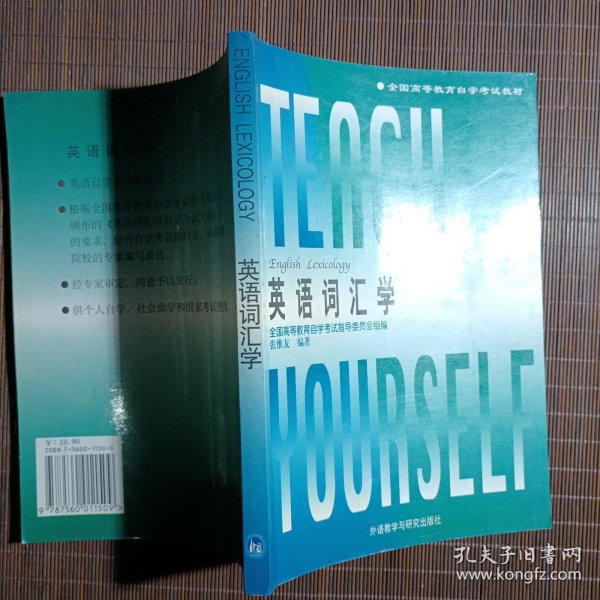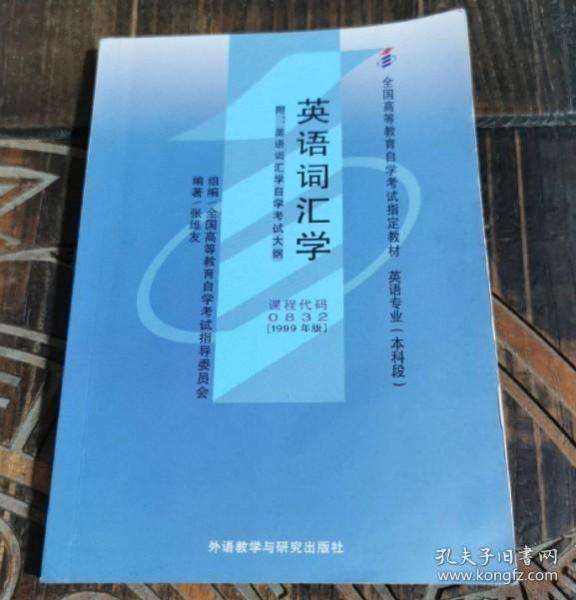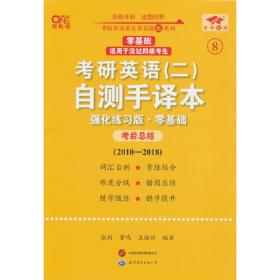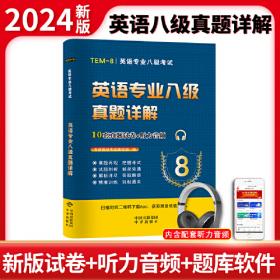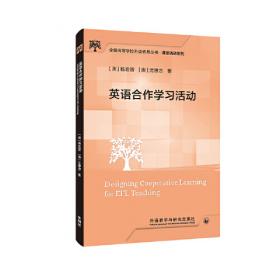英语词汇学
出版时间:
2000-01
版次:
1
ISBN:
9787560011509
定价:
12.90
装帧:
平装
开本:
32开
纸张:
其他
页数:
275页
正文语种:
简体中文,英语
376人买过
-
当您开始阅读《英语词汇学》时,人类已经迈入了21世纪。这是一个变幻难测的世纪,这是一个催人奋进的时代,科学技术飞速发展,知识更替日新月异。希望、困惑、机遇、挑战,随时随地都有可能出现在每一个社会成员的生活之中。抓住机遇,寻求发展,迎接挑战,适应变化的制胜法宝就是学习——依靠自己学习,终生学习。 Introduction
Chapter1BasicConceptsofW0rdsandVocabulary
1.1WhatIsaWord
1.2SoundandMeaning
1.3SoundandForm
1.4Vocabulary
1.5ClassificationofWords
1.5.1BasicWordStockandNonbasicVocabulary
1.5.2ContentWordsandFunctionalWords
1.5.3NativeWordsandBorrowedWords
QuestionsandTasks
Chapter2TheDevelopmentoftheEnglishVocabulary
2.1TheIndo-EuropeanLanguageFamily
2.2AHistoricalOverviewoftheEnglishVocabulary
2.2.1OldEnglish(450-1150)
2.2.2MiddleEnglish(1150-1500)
2.2.3ModernEnglish(1500一uptonow)
2.3GrowthofPresent-dayEnglishVocabulary
2.4ModesofVocabularyDevelopment
QuestionsandTasks
Chapter3WordFormation
3.1Morphemes
3.2Allomorphs
3.3TypesofMorphemes
3.3.1FreeMorphemes
3.3.2BoundMorphemes
3.4RootandStem
QuestionsandTasks
Chapter4WOrdFormationII
4.1Affixation
4.1.1Prefixation
4.1.2Surfixation
4.2Compounding
4.2.1CharacteristicsofCompounds
4.2.2FormationofCompounds
4.3Conversion
4.4Blending
4.5Clipping
4.6Acronymy
4.6.1Initialisms
4.6.2Acronyms
4.7Back-formation
4.8WordsfromProperNames
QuestionsandTasks
Chapter5WordMeaning
5.1TheMeaningsof‘Meaning
5.1.1Reference
5.1.2Concept
5.1.3Sense:
5.2Motivation
5.2.1OnomatopoeicMotivation
5.2.2MorphologicalMotivation
5.2.3SemanticMotivation
5.2.4EtymologicalMotivation
5.3TypesofMeaning
5.3.1GrammaticalMeaningandLexicalMeaning
5.3.2ConceptualMeaningandAssociativeMeaning
QuestionsandTasks
Chapter6SenseRelationsandSemanticField
6.1Polysemy
6.1.1TwoApproachestoPolysemy
6.1.2TwoProcessesofDevelopment
6.2Homonymy
6.2.1TypesofHomonyms
6.2.2OriginsofHomonyms
6.2.3DifferentiationofHomonymsfromPolysemant
6.2.4RhetoricFeaturesofHomonyms
6.3Synonymy
6.3.1DefinitionofSynonyms
6.3.2TypesofSynonyms
6.3.3SourcesofSynonyms
6.3.4DiscriminationofSynonyms
6.4Antonymy
6.4.1TypesofAntonyms
6.4.2SomeoftheCharacteristicsofAntonyms
6.4.3TheUseofAntonyms
6.5Hyponymy
6.6SemanticField
QuestionsandTasks
Chapter7ChangesinWordMeaning
7.1TypesofChanges
7.1.1Extension
7.1.2Narrowing
7.1.3Elevation
7.1.4Degradation
7.2CausesofChanges
7.2.1Extra-linguisticFactors
7.2.2LinguisticFactors
QuestionsandTasks
Chapter8MeaningandContext
8.1TypesofContext
8.1.1Extra-linguisticContext
8.1.2LinguisticContext
8.2TheRoleofContext
8.2.1EliminationofAmbiguity
8.2.2IndicationofReferents
8.2.3ProvisionofCluesforInferringWord-meaning
QuestionsandTasks
Chapter9EnglishIdioms
9.1CharacteristicsofIdioms
9.1.1SemanticUnity
9.1.2StructuralStability
9.2ClassificationofIdioms
9.2.1IdiomsNominalinNature
9.2.2IdiomsAdiectivalinNature
9.2.3IdiomsVerbalinNature
9.2.4IdiomsAdverbialinNature
9.2.5SentenceIdioms
9.3UseofIdioms
9.3.1StylisticFeatures
9.3.2RhetoricalFeatures
9.3.3VariationsofIdioms
QuestionsandTasks
Chapter10EnglishDictionaries
10.1TypesofDictionaries
10.1.1MonolingualandBilingualDictionaries
10.1.2LinguisticandEncyclopedicDictionaries
10.1.3Unabridged,DeskandPocketDictionaries
10.1.4SpecializedDictionaries
10.2UseofDictionaries
10.2.1ChoiceofDictionaries
10.2.2ContentoftheDictionary
10.2.3UseoftheDictionary
10.3ThreeGoodGeneralDictionaries
10.3.1LongrnanDictionaryofContemporary
English(LDCE)NewEdition(1987)
10.3.2CollinsCOBU儿DEnglishLanguageDictionary(CCELD)(1987)
10.3.3AChinese-EnglishDictionary(RevisedEdition)(CED)(1995)
QuestionsandTasks
SuggestedAnswers
ReferenceBooks
英语词汇学术语英汉对照表
后记
英语词汇学自学考试大纲
-
内容简介:
当您开始阅读《英语词汇学》时,人类已经迈入了21世纪。这是一个变幻难测的世纪,这是一个催人奋进的时代,科学技术飞速发展,知识更替日新月异。希望、困惑、机遇、挑战,随时随地都有可能出现在每一个社会成员的生活之中。抓住机遇,寻求发展,迎接挑战,适应变化的制胜法宝就是学习——依靠自己学习,终生学习。
-
目录:
Introduction
Chapter1BasicConceptsofW0rdsandVocabulary
1.1WhatIsaWord
1.2SoundandMeaning
1.3SoundandForm
1.4Vocabulary
1.5ClassificationofWords
1.5.1BasicWordStockandNonbasicVocabulary
1.5.2ContentWordsandFunctionalWords
1.5.3NativeWordsandBorrowedWords
QuestionsandTasks
Chapter2TheDevelopmentoftheEnglishVocabulary
2.1TheIndo-EuropeanLanguageFamily
2.2AHistoricalOverviewoftheEnglishVocabulary
2.2.1OldEnglish(450-1150)
2.2.2MiddleEnglish(1150-1500)
2.2.3ModernEnglish(1500一uptonow)
2.3GrowthofPresent-dayEnglishVocabulary
2.4ModesofVocabularyDevelopment
QuestionsandTasks
Chapter3WordFormation
3.1Morphemes
3.2Allomorphs
3.3TypesofMorphemes
3.3.1FreeMorphemes
3.3.2BoundMorphemes
3.4RootandStem
QuestionsandTasks
Chapter4WOrdFormationII
4.1Affixation
4.1.1Prefixation
4.1.2Surfixation
4.2Compounding
4.2.1CharacteristicsofCompounds
4.2.2FormationofCompounds
4.3Conversion
4.4Blending
4.5Clipping
4.6Acronymy
4.6.1Initialisms
4.6.2Acronyms
4.7Back-formation
4.8WordsfromProperNames
QuestionsandTasks
Chapter5WordMeaning
5.1TheMeaningsof‘Meaning
5.1.1Reference
5.1.2Concept
5.1.3Sense:
5.2Motivation
5.2.1OnomatopoeicMotivation
5.2.2MorphologicalMotivation
5.2.3SemanticMotivation
5.2.4EtymologicalMotivation
5.3TypesofMeaning
5.3.1GrammaticalMeaningandLexicalMeaning
5.3.2ConceptualMeaningandAssociativeMeaning
QuestionsandTasks
Chapter6SenseRelationsandSemanticField
6.1Polysemy
6.1.1TwoApproachestoPolysemy
6.1.2TwoProcessesofDevelopment
6.2Homonymy
6.2.1TypesofHomonyms
6.2.2OriginsofHomonyms
6.2.3DifferentiationofHomonymsfromPolysemant
6.2.4RhetoricFeaturesofHomonyms
6.3Synonymy
6.3.1DefinitionofSynonyms
6.3.2TypesofSynonyms
6.3.3SourcesofSynonyms
6.3.4DiscriminationofSynonyms
6.4Antonymy
6.4.1TypesofAntonyms
6.4.2SomeoftheCharacteristicsofAntonyms
6.4.3TheUseofAntonyms
6.5Hyponymy
6.6SemanticField
QuestionsandTasks
Chapter7ChangesinWordMeaning
7.1TypesofChanges
7.1.1Extension
7.1.2Narrowing
7.1.3Elevation
7.1.4Degradation
7.2CausesofChanges
7.2.1Extra-linguisticFactors
7.2.2LinguisticFactors
QuestionsandTasks
Chapter8MeaningandContext
8.1TypesofContext
8.1.1Extra-linguisticContext
8.1.2LinguisticContext
8.2TheRoleofContext
8.2.1EliminationofAmbiguity
8.2.2IndicationofReferents
8.2.3ProvisionofCluesforInferringWord-meaning
QuestionsandTasks
Chapter9EnglishIdioms
9.1CharacteristicsofIdioms
9.1.1SemanticUnity
9.1.2StructuralStability
9.2ClassificationofIdioms
9.2.1IdiomsNominalinNature
9.2.2IdiomsAdiectivalinNature
9.2.3IdiomsVerbalinNature
9.2.4IdiomsAdverbialinNature
9.2.5SentenceIdioms
9.3UseofIdioms
9.3.1StylisticFeatures
9.3.2RhetoricalFeatures
9.3.3VariationsofIdioms
QuestionsandTasks
Chapter10EnglishDictionaries
10.1TypesofDictionaries
10.1.1MonolingualandBilingualDictionaries
10.1.2LinguisticandEncyclopedicDictionaries
10.1.3Unabridged,DeskandPocketDictionaries
10.1.4SpecializedDictionaries
10.2UseofDictionaries
10.2.1ChoiceofDictionaries
10.2.2ContentoftheDictionary
10.2.3UseoftheDictionary
10.3ThreeGoodGeneralDictionaries
10.3.1LongrnanDictionaryofContemporary
English(LDCE)NewEdition(1987)
10.3.2CollinsCOBU儿DEnglishLanguageDictionary(CCELD)(1987)
10.3.3AChinese-EnglishDictionary(RevisedEdition)(CED)(1995)
QuestionsandTasks
SuggestedAnswers
ReferenceBooks
英语词汇学术语英汉对照表
后记
英语词汇学自学考试大纲
查看详情
-
2010-10 印刷
印次: 15
八五品
河南省濮阳市
平均发货21小时
成功完成率96.67%
-
八五品
上海市闵行区
平均发货13小时
成功完成率97.45%
-
英语词汇学
正版二手,均有笔记不影响使用,无赠品、光盘、MP12等。如需购买套装书,请联系客服核实,批量上传数据有误差,套装书售后运费自理,还请见谅!
八五品
山东省枣庄市
平均发货9小时
成功完成率88.01%
-
八五品
湖南省长沙市
平均发货14小时
成功完成率91.55%
-
九品
北京市通州区
平均发货10小时
成功完成率87.32%
-
英语词汇学
开学大优惠,我们以更好的服务和质量迎接新的挑战!春季开学优惠活动进行中!
九品
北京市通州区
平均发货10小时
成功完成率92.67%
-
九品
北京市通州区
平均发货10小时
成功完成率87.32%
-
九品
北京市通州区
平均发货10小时
成功完成率87.32%
-
九品
辽宁省营口市
平均发货4小时
成功完成率95.67%
-
八五品
河北省石家庄市
平均发货5小时
成功完成率97.91%
-
英语词汇学
正版二手,批量上传数据有误差,套装请咨询客服,均有笔记不影响使用,无赠品、光盘、MP3等
八五品
山东省枣庄市
平均发货12小时
成功完成率86.59%
-
九五品
江西省南昌市
平均发货24小时
成功完成率84.82%
-
九品
江西省南昌市
平均发货21小时
成功完成率85.49%
-
八五品
河南省郑州市
平均发货11小时
成功完成率92.36%
-
英语词汇学
批量上传,套装书可能不全,下单前咨询在线客服!图书都是8-9成新,少量笔记,不影响阅读使用!光盘、学习卡、附件等默认不带,有特殊要求,下单前请咨询客服!
九品
广东省佛山市
平均发货8小时
成功完成率91.15%
-
英语词汇学
批量上传,套装书可能不全,下单前咨询在线客服!图书都是8-9成新,少量笔记,不影响阅读使用!光盘、学习卡、附件等默认不带,有特殊要求,下单前请咨询客服!
九品
北京市通州区
平均发货10小时
成功完成率89.87%
-
英语词汇学
正版二手8-9成新左右,可能会有少量涂画,整体不影响再次阅读使用!套装不一定齐全,请下单前咨询在线客服!
九品
河北省廊坊市
平均发货8小时
成功完成率93.78%
-
英语词汇学
批量上传,套装书可能不全,下单前咨询在线客服!图书都是8-9成新,少量笔记,不影响阅读使用!
九品
河北省廊坊市
平均发货8小时
成功完成率93.78%
-
九五品
北京市通州区
平均发货30小时
成功完成率86.89%
-
八五品
河北省衡水市
平均发货14小时
成功完成率96.18%
-
九品
湖北省武汉市
平均发货21小时
成功完成率91.75%
-
八五品
湖北省咸宁市
平均发货19小时
成功完成率88.16%
-
八五品
山东省枣庄市
平均发货18小时
成功完成率88.51%
-
八五品
四川省成都市
平均发货9小时
成功完成率95.55%
-
八五品
江苏省无锡市
平均发货24小时
成功完成率93.21%
-
八五品
江苏省无锡市
平均发货15小时
成功完成率95.73%
-
英语词汇学
正版现货,品相完好,套装书默认发一本,多封面版本图书请咨询客服再下单
九品
北京市海淀区
平均发货23小时
成功完成率85.99%
-
九品
湖北省武汉市
平均发货27小时
成功完成率93.9%
-
八五品
四川省成都市
平均发货6小时
成功完成率94.84%
-
八五品
四川省成都市
平均发货8小时
成功完成率94.49%
-
九五品
河南省商丘市
平均发货18小时
成功完成率90.06%
-
八五品
天津市西青区
平均发货14小时
成功完成率90.33%
-
九品
湖北省武汉市
平均发货24小时
成功完成率90.09%
-
英语词汇学
本店经营图书主为8-95品二手书,本着认真负责的态度上传图书,尽可能详细的反应书本的真实情况.
九五品
北京市通州区
平均发货21小时
成功完成率94.44%
-
八五品
河南省濮阳市
平均发货8小时
成功完成率96.58%
-
八五品
河南省濮阳市
平均发货8小时
成功完成率96.58%
-
八五品
四川省成都市
平均发货8小时
成功完成率91.29%
-
八五品
四川省成都市
平均发货8小时
成功完成率92.15%
-
九五品
河南省商丘市
平均发货18小时
成功完成率90.06%
-
九品
上海市松江区
平均发货25小时
成功完成率90.37%
-
八五品
广东省东莞市
平均发货11小时
成功完成率95.35%
-
英语词汇学
【正版有货可开发票;库存情况请咨询,及标题与图片不一致时】
全新
广东省广州市
平均发货8小时
成功完成率89.96%
-
九品
山东省泰安市
平均发货14小时
成功完成率96.1%
-
九五品
北京市丰台区
平均发货19小时
成功完成率86.25%
-
七五品
河南省濮阳市
平均发货8小时
成功完成率96.58%
-
全新
江苏省南京市
平均发货44小时
成功完成率76.49%
-
八五品
江苏省南京市
平均发货19小时
成功完成率82.29%
-
九品
湖北省武汉市
平均发货27小时
成功完成率91.05%
-
八品
湖南省湘潭市
平均发货1小时
成功完成率93.77%
-
九品
四川省成都市
平均发货8小时
成功完成率95.13%

 占位居中
占位居中

